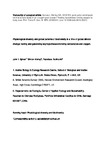Physiological diversity, biodiversity patterns and global climate change: testing key hypotheses involving temperature and oxygen
| dc.contributor.author | Spicer, John | |
| dc.contributor.author | Morley, SA | |
| dc.contributor.author | Bozinovic, F | |
| dc.date.accessioned | 2019-06-20T19:18:29Z | |
| dc.date.available | 2019-06-20T19:18:29Z | |
| dc.date.issued | 2019-06-17 | |
| dc.identifier.issn | 0962-8436 | |
| dc.identifier.issn | 1471-2970 | |
| dc.identifier.other | ARTN 20190032 | |
| dc.identifier.uri | http://hdl.handle.net/10026.1/14348 | |
| dc.description.abstract |
<jats:p>Documenting and explaining global patterns of biodiversity in time and space have fascinated and occupied biologists for centuries. Investigation of the importance of these patterns, and their underpinning mechanisms, has gained renewed vigour and importance, perhaps becoming pre-eminent, as we attempt to predict the biological impacts of global climate change. Understanding the physiological features that determine, or constrain, a species' geographical range and how they respond to a rapidly changing environment is critical. While the ecological patterns are crystallizing, explaining the role of physiology has just begun. The papers in this volume are the primary output from a Satellite Meeting of the Society of Experimental Biology Annual Meeting, held in Florence in July 2018. The involvement of two key environmental factors, temperature and oxygen, was explored through the testing of key hypotheses. The aim of the meeting was to improve our knowledge of large-scale geographical differences in physiology, e.g. metabolism, growth, size and subsequently our understanding of the role and vulnerability of those physiologies to global climate warming. While such an aim is of heuristic interest, in the midst of our current biodiversity crisis, it has an urgency that is difficult to overstate.</jats:p> <jats:p>This article is part of the theme issue ‘Physiological diversity, biodiversity patterns and global climate change: testing key hypotheses involving temperature and oxygen’.</jats:p> | |
| dc.format.extent | 20190032-20190032 | |
| dc.format.medium | Print-Electronic | |
| dc.language | en | |
| dc.language.iso | en | |
| dc.publisher | Royal Society, The | |
| dc.subject | macrophysiology | |
| dc.subject | biodiversity gradients | |
| dc.subject | ecological physiology | |
| dc.subject | conservation physiology | |
| dc.title | Physiological diversity, biodiversity patterns and global climate change: testing key hypotheses involving temperature and oxygen | |
| dc.type | journal-article | |
| dc.type | Introductory Journal Article | |
| dc.type | Research Support, Non-U.S. Gov't | |
| plymouth.author-url | https://www.webofscience.com/api/gateway?GWVersion=2&SrcApp=PARTNER_APP&SrcAuth=LinksAMR&KeyUT=WOS:000473329200009&DestLinkType=FullRecord&DestApp=ALL_WOS&UsrCustomerID=11bb513d99f797142bcfeffcc58ea008 | |
| plymouth.issue | 1778 | |
| plymouth.volume | 374 | |
| plymouth.publication-status | Published | |
| plymouth.journal | Philosophical Transactions of the Royal Society B: Biological Sciences | |
| dc.identifier.doi | 10.1098/rstb.2019.0032 | |
| plymouth.organisational-group | /Plymouth | |
| plymouth.organisational-group | /Plymouth/Faculty of Science and Engineering | |
| plymouth.organisational-group | /Plymouth/Faculty of Science and Engineering/School of Biological and Marine Sciences | |
| plymouth.organisational-group | /Plymouth/REF 2021 Researchers by UoA | |
| plymouth.organisational-group | /Plymouth/REF 2021 Researchers by UoA/UoA07 Earth Systems and Environmental Sciences | |
| plymouth.organisational-group | /Plymouth/Research Groups | |
| plymouth.organisational-group | /Plymouth/Research Groups/Marine Institute | |
| plymouth.organisational-group | /Plymouth/Users by role | |
| plymouth.organisational-group | /Plymouth/Users by role/Academics | |
| dc.publisher.place | England | |
| dcterms.dateAccepted | 2019-05-04 | |
| dc.rights.embargodate | 2019-9-3 | |
| dc.identifier.eissn | 1471-2970 | |
| dc.rights.embargoperiod | Not known | |
| rioxxterms.versionofrecord | 10.1098/rstb.2019.0032 | |
| rioxxterms.licenseref.uri | http://www.rioxx.net/licenses/all-rights-reserved | |
| rioxxterms.licenseref.startdate | 2019-06-17 | |
| rioxxterms.type | Journal Article/Review |


